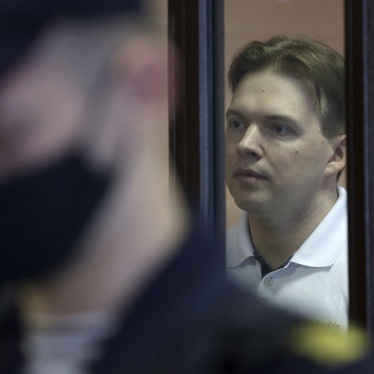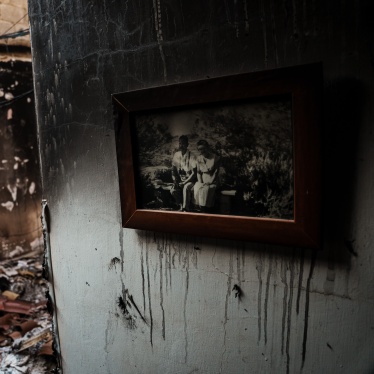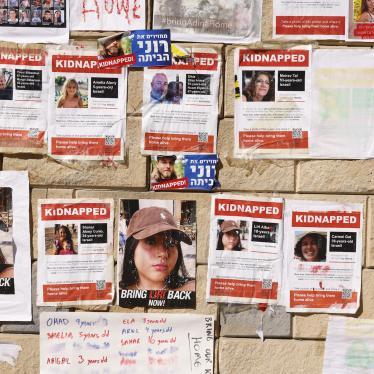(Moscow) – Russian authorities should promptly and effectively investigate reports of excessive use of force against protesters and arbitrary detentions during and following a protest on May 6, 2012, Human Rights Watch said today. The authorities should also investigate the allegedly arbitrary detention of hundreds of activists demonstrating peacefully on May 7, Human Rights Watch said.
In the late afternoon of May 6, tens of thousands of protesters marched in central Moscow and began to assemble for a rally sanctioned by the Moscow authorities at Bolotnaya Square, near the Kremlin. After a bottleneck created by police security held up thousands of the protesters on the way to the main rally site, several leaders of the opposition called a sit-down strike and a handful of protesters tried to break through a police line, in some cases using violence. Police responded with force, including using rubber truncheons, detaining hundreds of people, including peaceful protesters as well as those who were acting aggressively.
“Though some protesters apparently disobeyed police orders and even attacked police officers, we received many credible reports of police detaining peaceful protesters along with those who violated the law,” said Hugh Williamson, Europe and Central Asia director at Human Rights Watch. “We are also concerned about allegations of police brutality, including beatings and causing unnecessary pain and suffering.”
The May 6 protest was the first in which violence erupted since public protests began on a periodic basis in December 2011.
Human Rights Watch is concerned that the Russian authorities are using the disorderly behavior of some of the demonstrators on May 6 as a pretext to further curb freedom of assembly. According to the European Court of Human Rights, an unauthorized peaceful protest does not justify an infringement on freedom of assembly, but requires a certain degree of tolerance on the part of the authorities. The government also has a duty to investigate and remedy violations of those obligations.
The right of peaceful assembly is guaranteed by the European Convention on Human Rights (ECHR) as well as the International Covenant on Civil and Political Rights (ICCPR), to which Russia is a party, as well as by the Russian Constitution. As the European Court of Human Rights has made clear, the freedom to take part in a peaceful assembly is of such importance that a person cannot be subjected to a sanction – even one at the lower end of the scale of disciplinary penalties – for participation in a demonstration that has not been prohibited, so long as this person does not himself commit any reprehensible act on such an occasion.
“Contentious protests happen all over the world and human rights law imposes a duty on the state to protect the public from violence,” Williamson said. “However, the authorities should not use violent actions by some protesters to attack human rights, including the rights to free assembly and free expression.”
Accounts from witnesses of the events on May 6 and 7 follow.
The May 6 Protest
Media reports variously estimate that in the late afternoon of May 6 between 20,000 and 60,000 demonstrators marched from the south of the city center north along Bolshaya Yakimanka Street in central Moscow. The marchers included opposition activists, as well as high school students, elderly people, and others. The protesters headed toward Bolotnaya Square, just across the river from the Kremlin, to the site of a planned rally by opposition political parties and civil society activists protesting the inauguration of Vladimir Putin as president. The protest was peaceful for the first hour.
However, according to media reports and video footage, a bottleneck was created between metal detectors manned by police at the entrance to Bolotnaya Square and the police cordons blocking the road toward the Kremlin. While the demonstrators at the head of the processions successfully made it to the square, a column of thousands of demonstrators was held up. People were eventually backed up several hundred meters on Bolshaya Polyanka Street, leading from Bolshaya Yakimanka to Bolotnaya Square, waiting to reach the rally site.
Apparently frustrated at the delay, several recognized leaders of the protest movement, including Sergei Udaltsov, Alexei Navalny and Ilia Yashin, declared a “sit-down political strike.” They sat on the ground in front of the police line and called on others to join them. According to media reports, Udaltsov voiced their demands as “one hour of federal television time, suspension of Putin’s inauguration, and re-elections.” The strikers started singing a famous revolutionary song and made calls and sent messages to others, including on Twitter, to bring food, water, and tents and to stay put.
Based on video footage examined by Human Rights Watch, shortly after 6 p.m., a group of young aggressive protesters tried to break through the police cordon. Riot police officers used rubber batons against them and detained several protesters. Some succeeded in breaking through the police cordon. One threw an improvised incendiary device in a bottle at police, but the flames instead set the clothes of another demonstrator on fire. Police officers and other protesters helped put out the flames. After the homemade incendiary device was thrown, protracted and violent confrontations between riot police and aggressive protesters ensued.
Udaltsov and Navalny managed to make their way to Bolotnaya Square soon after the police cordon had been breached. Udaltsov went to the podium and, using two loudspeakers, called on people to stay in the square indefinitely. Police dragged him off the stage and detained him together with Navalny. Both spent the night in custody, were tried the next day for “disobeying police orders,” and sentenced to pay 1,000-ruble [approximately US$30] fines.
During the next two hours, police detained large numbers of protesters. Human Rights Watch researchers witnessed some of the detentions. The Human Rights Watch researchers also interviewed numerous witnesses to detentions, all of whom asserted that they saw people who did not engaged in violence detained along with those who violated public order. The witnesses consistently said the police had used force, irrespective of whether detainees were presenting a threat to police or others.
Accounts of Police Violence
Several activists interviewed by Human Rights Watch, including two who were themselves detained, said that riot police in full gear dragged protesters by their arms and feet, twisted their arms, and stomped on people who had fallen to the ground. Witnesses also reported that some people were bleeding from being hit or dragged by police along the asphalt and that at least three demonstrators had to be hospitalized after being released from police precincts later in the evening.
One witness, Sergei Davidis, a human rights lawyer, and an organizer of the event, said:
People were being arrested indiscriminately all over the place. The use of force was not targeted just against those manifesting aggression. One [peaceful] woman, for example, was shocked with an electroshock weapon. I saw many people beaten by police. They used batons a lot, including against those people who were standing there peacefully and just could not get out of the crowd.
Riot police officers hit Alexei Pomerantsev, a journalist from the prominent independent newspaper Novaya Gazeta, with batons and dragged him to join other detainees held in a reinforced vehicle. Novaya Gazeta reported that Pomerantsev was released quickly, once he was able to show his media identification to a police officer in charge of the vehicle.
Dmitry Oreshkin - a prominent policy social scientist and member of Russia’s Presidential Civil Society and Human Rights Council, a group of prominent civil society activists and experts recruited by the president to advise him on human rights issues - told Human Rights Watch what he saw. He said that when the bottleneck created by police was causing demonstrators around him to be pushed together and the crowd was growing increasingly agitated, he decided to intervene with the police, using his official credentials.
Oreshkin said that police roughed him up as he tried to speak to them. “I started asking them to let people proceed to the square, to give them more space, to give them more space by moving the police chain some 10 meters back, but they ignored me,” Oreshkin said. “I tried to get through the chain waving my ID to speak to some officials in command, but they would not let me. Several officers stomped on my feet. I received a punch in my stomach. They did something to my hand – it started bleeding… Finally, some [more senior official] came up and ordered to let me though.”
A member of the Presidential Civil Society and Human Rights Council, Elena Panfilova, who is the head of the Russia Chapter for Transparency International, was at the protest and witnessed many of the detentions. She emphasized to Human Rights Watch that she was particularly distressed by the roughness of detentions, in which police twisted people’s arms and dragged them on the ground. She indicated that according to her observations, it was specifically riot police – as opposed to regular police officers – who engaged in excessive force. Panfilova also believed that the authorities “generally created a situation in which many perfectly orderly peaceful citizens, some of them with their whole families, were trapped in the crowd amid violence without any escape options.”
“Even when public protests become disorderly and police officials face violence from some of the demonstrators, it does not justify the use of excessive and indiscriminate force and arbitrary detentions,” Williamson said.
Witnesses in other locations, including farther up Bolshaya Yakimanka Street before and after the outbreak of violence, stated that protesters had become increasingly nervous as they did not know what was happening, and were being squeezed from all sides by fellow demonstrators and police.
After several minutes of general chaos on Bolotnaya Square following the announcement of the sit-down strike on the other side of the police cordon, some people chose to leave the square and others headed back to the entrance of the square to find out what was going on. At first the police would not let people proceed in that direction. Only after the intervention of several observers from the Presidential Council and the Ombudsman did the police allow demonstrators to leave via the small Luzhkov Bridge across the canal.
“Good policing means effectively managing large crowds of peaceful people to ensure that they can safely exercise their right to express themselves,” Williamson said. “Unfortunately the police in central Moscow failed to create the right conditions for many of the people gathered there to leave the area safely once the situation turned chaotic.”
Panfilova said that she and other observers from the Presidential Council tried to intervene with the police when they saw police acting in a way they considered abusive. But she said such attempts were useless in trying to rein in the riot police. “We tried to do something about the number and brutality of detentions by intervening with the leadership of the Moscow police, but it seems that the riot police would not even listen to them,” Panfilova said.
Violence by Protesters
Some protesters also resorted to violence against police. Human Rights Watch researchers saw some protesters use smoke bombs and pelt police officers with water bottles, empty and full. Several witnesses also confirmed to Human Rights Watch numerous media reports that aggressive youths threw chunks of asphalt and stones at police. Some demonstrators also turned over several portable toilets in an attempt to make barricades and threw a flagpole at the police.
A witness told Human Rights Watch that a stone hit a policeman in the face and that he bled profusely. Another witness told Human Rights Watch that he saw two incidents in which protesters attacked individual police officers and beat them with hands and fists. Some protesters snatched helmets and radios from police officers, and threw them into the canal.
According to official reports by the Minister of Internal Affairs, 20 officers were injured and 3 required hospitalization. Video footage indicates that some protesters used mace against the police. A Human Rights Watch researcher saw a crowd of demonstrators throw orange and banana peels, bottles and all sorts of street garbage at a car belonging to NTV, a pro-governmental federal television channel known for its efforts to discredit the opposition.
Detentions and Military Conscription
By 10 p.m. on May 6, the Internal Affairs Ministry reported that law enforcement officials had detained over 400 people. On May 7, however, OVD Info, an independent website featuring information about police detentions during public protests, indicated that about 650 people had been arrested, providing most of the names and identifying specific police precincts where people were held.
Some were released several hours later. Others were held overnight. The majority of those tried the next day were sentenced to fines of up to 1,000 rubles [approximately US$30] for “violating the established procedure for arranging or conducting a demonstration” or for disobeying police, although a few protesters were sentenced to several days of administrative detention. Many protesters, while released, are still awaiting trial.
Human Rights Watch is also looking into several cases in which protesters of conscription age were presented with notification that they had been called to perform their military service. Numerous media and blog accounts also reported multiple cases in which this happened.
Military service in Russia is infamous for brutal hazing and other grave abuses of the rights of conscripts. As a result, draft quotas are hard to meet as most men of conscription age seek to avoid service, whether through deferments or other means. In 2002 Human Rights Watch published a report documenting the illegal practice by police of detaining young men to deliver them to military recruitment offices, although police should have no role in draft enforcement. Based on reports from detainees, it would appear the government is now using the police to issue draft notifications as a punitive and intimidation measure against young protest activists, Human Rights Watch said.
"To use the well-founded fear of exposure to abuse and harm in the draft system as a form of punishment to discourage young men from taking part in public protests, is an outrageous and cynical tactic," Williamson said.
May 7 Protests
On May 7, while the presidential inauguration ceremony was in progress, small groups of peaceful activists came together in several locations in central Moscow to express their frustration that Putin was becoming Russia’s president for the third time. Many wore white ribbons, the symbol of the protest movement, and chanted slogans. Some played musical instruments and sang.
Media and blog reports said that the police “mopped up” the city center and even raided some popular cafes, detaining anyone they saw wearing white ribbons. OVD Info reported that 499 peaceful protestors were detained on May 7. Practically all of them were released after being held for a short period. On May 8, similar detentions of peaceful street protesters continued, with dozens more people detained by early afternoon.




